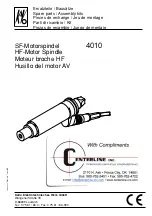
31
MAINTENANCE
WARNING: To reduce the risk of injury, always unplug the tool before doing any
maintenance. Never disassemble the tool or try to do any rewiring to its
electrical system. Contact a qualified electrician for electrical repairs.
Always follow lockout/tagout procedures when servicing electrical
equipment.
General Maintenance
Keep the tool in good repair by adopting a regular maintenance program. Before each day’s use, examine the
general condition of the tool, and inspect the guards, switches, power cord, and extension cord for damage.
Check for loose screws, misalignment, binding of moving parts, improper mounting, broken parts, and any other
condition that may affect its safe operation. If abnormal noise or vibration occurs, turn the tool off immediately
and have the problem corrected before further use. Do not use a damaged tool. Tag damaged tools “DO NOT
USE” until repaired (see “Repairs”).
Cleaning
Daily, clean all dust and debris from the vents in the motor housing.
Keep the handles clean, dry and free from oil and grease.
Use only mild soap and a damp cloth to clean the tool, because certain cleaning agents and solvents are harmful
to plastics and other insulated parts. Some of these include: gasoline, turpentine, lacquer thinner, paint thinner,
chlorinated cleaning solvents, ammonia, and household detergents containing ammonia. Never use flammable
or combustible solvents around tools.
WARNING: To reduce the risk of injury, electric shock, and damage to the tool, never
immerse the saw or router in liquid or allow a liquid to flow inside it.
Maintaining the Motor
Under normal conditions, motor maintenance is not necessary until the brushes need to be replaced.
Every six months:
•
Inspect the brushes, and replace as necessary.
•
Mechanically inspect and clean the gears, spindles, bearings, housing, etc.
•
Electrically inspect the switch, cord, armature, etc.
•
Test to assure proper mechanical and electrical operation.
Lubricating the Guides
The carriage should move smoothly up and down the guide tubes or rails. However, if the guides become caked
with dust or debris, the carriage may get stuck or it may not slide smoothly. Periodically clean the guides with a
damp cloth, following the directions under “Cleaning” above. Then use a dry lubricant such as a spray silicone.
Other lubricants cause dust and debris to collect on the guides and contaminate the bearings.













































